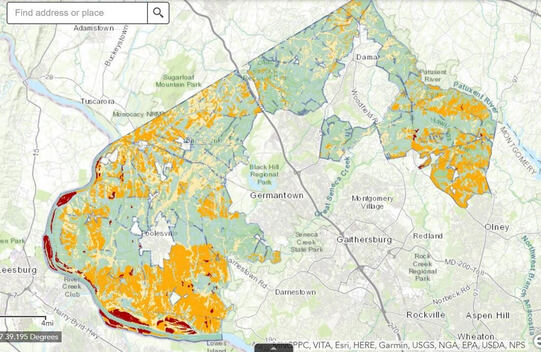There have been a large number of claims made about the merits of ZTA 20-01 (amended version)– a proposal that would allow 3 square miles of solar arrays on farmland in the Agricultural Reserve. Here we investigate the claims of the ZTAs backers:
Fact: Conditional Use is the only legal pathway forward for these solar arrays in the Ag Reserve. They are a public utility and as such fall under conditional use - same as radio and cell towers and power lines. The conditional use process takes an average of 6 months. If allowed as a limited use as written, forests are only protected on a site by site basis, farmers lose out on leases because they can't compete with solar companies and there is no mitigation for the erosion caused by these projects that will impact local streams. Read on for more specifics on each of these impacts.
Fact: It is a lose-lose-lose for pollinators, both current and future farmers and the consumers who rely on them.While co-location of agriculture is mentioned in the ZTA, there is no requirement or incentive for farming to happen under the arrays. The area "must be maintained in a manner suitable for grazing farm animals." i.e - grass. The referenced Maryland "pollinator friendly" provisions of the state certification program are coming under fire from Clean Water Action and other state groups as certified habitat can still be routinely sprayed with pesticides. (See the scorecard here.)
-The ZTA has not yet been approved and already local landowners are receiving lease offers far higher- sometimes 10 and 20 times higher- than the going rate of agricultural land leases. More than half of the acres farmed in the Reserve are leased. So the economics will mostly benefit non-farming landowners. According to some farmers, just the debate over this proposal has landowners not renewing leases with farmers in preparation for putting farmed land under commercial arrays.
-In an attempt to increase local food production and land access we are keenly focused on pairing more sustainable table crop farmers with long term leased land through our Land Link program. Make no mistake - this ZTA will drastically hinder that effort. Bottom line – Should this ZTA pass, solar leases will out-compete farming leases in the only area of the county set aside for farming.
Fact: This is true.
That is why the county has completed a year long Climate Change Working Group study to chart a course toward reaching the County’s necessary goal of climate neutrality. The report is full of recommendations that are ready for the Council to put into practice now. The report, importantly, also expressly advises against siting solar on productive farmland/forests to protect the services provided by natural systems and secure future food system resilience.
As for cleaning the grid - our friends at Sugarloaf Citizens Association secured solar experts to look over this ZTA - 4% of the power generated would stay in the county (p. 8)- the rest would flow to the grid in other states.
Fact: Not so.
The ZTA leaves the protection of trees up to each individual site plan review as they come through the Planning Board. Increasingly granting waivers and exceptions, collecting fees instead of preservation, are the accepted practice.
In the town of Poolesville, 3 acres of forest were cleared to site a 6 acre array with no forest mitigation plan – we have asked the proponents of this ZTA for clarity on how that happened and are still awaiting a response.
Fact: This is not Community Solar.
This ZTA does not provide for affordable and local Community Solar alone and that option was only added to the proposed ZTA after repeated requests. Community Solar is a specific state of Maryland program started in 2015 that benefits low income residents with locally produced renewable solar energy sold at locked in low rates. The ZTA does not require that the commercial arrays be part of this specific program. The projects can be, according to the ZTA current version - either Community Solar or net metered aggregate projects which are not bound by Community Solar requirements, notably consumer protection from predatory pricing, nor is the renewable energy consumed in MC bring largely fed to the regional power grid. In fact, this ZTA is being heavily promoted by representatives of third party energy distributors that are currently being investigated for predatory pricing. Far more on this here.
Fact: Water runs downhill.
While construction on stream buffers is prohibited, the ZTA allows these arrays on up to 15% slopes. Any cyclist will tell you a 15% grade is a sizable hill. This just about guarantees that runoff from construction and more and more frequent large rain events will end up in local streams. Similar to the lack of forest protection, leaving these decisions to the site planning process relegates water quality to an afterthought in an area entirely on wells by design, most of them drawing from a federally designated sole source aquifer.
Let’s do facts as we deploy the systematic means to mitigate and adapt to our changing climate. The Reserve will serve as a critical tool toward achieving resilience in the decades to come.







